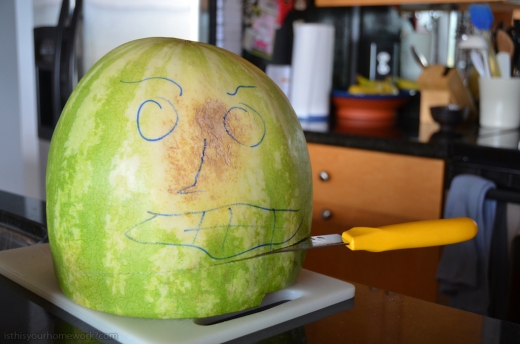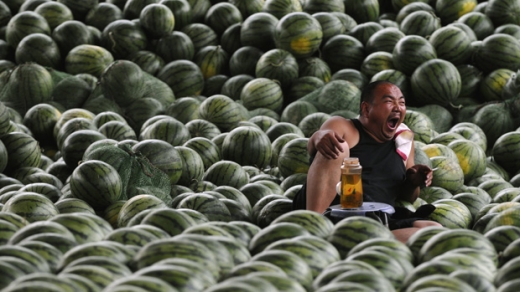I remember when you could get both seedless and true watermelon. I remember trying the seedless version. It was but a pale shadow of the vibrantly red, beautifully sweet, and deliciously refreshing true seeded wonder-food.
A true watermelon was pure ambrosia for a child. Similar in colour and property to the high-octane hummingbird food which fuels their unbounded energy, a watermelon served as the perfect pit-stop for young racing machines. Whether participating at the Picnic Grand Prix, the Baseball 500, or the Beach Superspeedway, every nanosecond spent on pit-row eating or drinking meant that you were missing out on everything that was going on.
In this way, watermelon seemed as if it were purpose engineered to suit the needs of youth. Not only would it provide both requirements of life, sugar and liquid, but your last piece could be taken on the go, shaving precious moments off your down-time.
That your hands, face, chest, and right forearm from elbow toward wrist would be smeared with stickiness was inconsequential to a kid. It would be washed off by the next plunge, or covered up by a film of dirt, or perhaps neither. To paraphrase a line from Predator: “Ain’t got time to clean”. It’s not that a conscious decision was made by an elite commando to ignore his wound, nor does a kid intentionally ignore the slathering of gluey juice, rather it simply isn’t on the radar of ‘Things That Are Important Right Now’.
Of course, when that final wedge was finished, you were left with a rind of the perfect size and weight that needed to be hucked into the woods/lake/ocean or sometimes onto the roof. It was food after-all, so it wasn’t littering.
When it came to devouring habits, there were two kinds, seed spitters and seed eaters. Kids are universally attracted to any endeavour where normal taboos become socially acceptable; the spitting of watermelon seeds is no exception. However for many, that activity required far too much care and attention to be bothered with.
When you reach a certain age, around eight or so, you’ve pretty well figured out the world. You don’t worry that swallowing the seeds will result in a watermelon growing out of your belly any more than you worry that swallowed gum stays in your stomach for seven years. That’s first-grade stuff. You’re immune to the legends and mythology of watermelons, even if you can’t help but visualize a green vine sprouting out of your belly button each time you crunch down on a big black seed and swallow it. The fact that you don’t eat too far down the rind has much more to do with the nutritive content and huckability of the leftover than with any childish worry that eating too much rind will immediately give you a stomach ache and diarrhea.
That watermelon can be custom-tailored to suit your exact mood, plays no small part in the everlasting love we have for it.
There’s more to a watermelon than just its value as sustinance. Even the long, oblong shape of a true watermelon implied a cornucopia of happiness. For days upon days you could cut off a round, seemingly without changing the size or shape of the remainder. The uniformity of each piece was comforting. It was as if the watermelon itself was unconcerned with beginnings and ends, rather it would reinforce the eternity of Summer Vacation through its unwavering consistency.
Neither the anticipatory opening cap of the watermelon, nor the inherently mournful nature of the end of a watermelon capture its true spirit. Emotionality aside, the very shape of each is somewhat dictatorially prescriptive it its available means of slicing and partaking. No, instead it is the middle-part which itself is the watermelon. It is the sweetest and juiciest part, the section in which the fruit-to-rind ratio is maximal, where the geometry of slicing depends upon the mood of the day, rather than upon the needs dictated by the end cap.
Important decisions have to be made which have subtle, yet deep effects on the entire experience. The differences between an extra-thick sixth of a round and a thin twelfth of a round are profound. One can cut methodically, carefully cutting for most efficient eating, or one can take a more free-spirited approach, allowing the knife to expose the sculpture hiding within the fruit. That watermelon can be custom-tailored to suit your exact mood, plays no small part in the everlasting love we have for it.
With the seedless facsimile, just as you enter the middle section, just as your sense-memories begin to transport you back in time, the watermelon has already begun to taper off to an end. Lost is its elongated shape, and with that we’ve also lost that time-stretching magic that the middle part of a true watermelon can conjure. Is it that the world is too fast-paced for endless watermelon, or perhaps the other way around? Has the shortening periodicity of our activities contributed to the breakneck speed of life? Could it be that we can extend our Summers, our lives, with something as simple as a true watermelon?
Today though, things are different. In our adulthood, watermelon is no longer the beautifully sticky, pink highlighter which once underscored important events of the days of high adventure that were our Summer Vacations.
For many of us watermelon has become a curio, a niche food for summertime barbecues, a fruit we enjoy, but no longer one that fuels the child within us. We eat seedless watermelon, and we enjoy it. Perhaps though, only because we’ve forgotten what a true watermelon tastes like, forgotten its power to change us and how we experience the world.
For me though, when I tuck into a delicious seedless watermelon, I don’t notice anything missing. I still feel sense-memories of its seeded cousin. I am still transported back to the days of carefree and timeless Julys, of the sharp tangy smell of swimming pools mixed with the thickly sweet odour of cut grass, of salted brows, darkly tanned necks, and leathered feet. And yet, each time I reach the rind on a piece of seedless watermelon, I can’t help but wonder:
Is there more?








